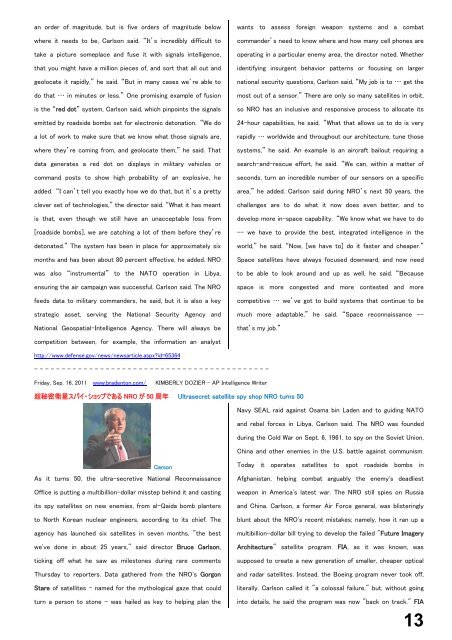24 - Space-Library
24 - Space-Library
24 - Space-Library
You also want an ePaper? Increase the reach of your titles
YUMPU automatically turns print PDFs into web optimized ePapers that Google loves.
an order of magnitude, but is five orders of magnitude below<br />
where it needs to be, Carlson said. “It’s incredibly difficult to<br />
take a picture someplace and fuse it with signals intelligence,<br />
that you might have a million pieces of, and sort that all out and<br />
geolocate it rapidly,” he said. “But in many cases we’re able to<br />
do that … in minutes or less.” One promising example of fusion<br />
is the “red dot” system, Carlson said, which pinpoints the signals<br />
emitted by roadside bombs set for electronic detonation. “We do<br />
a lot of work to make sure that we know what those signals are,<br />
where they’re coming from, and geolocate them,” he said. That<br />
data generates a red dot on displays in military vehicles or<br />
command posts to show high probability of an explosive, he<br />
added. “I can’t tell you exactly how we do that, but it’s a pretty<br />
clever set of technologies,” the director said. “What it has meant<br />
is that, even though we still have an unacceptable loss from<br />
[roadside bombs], we are catching a lot of them before they’re<br />
detonated.” The system has been in place for approximately six<br />
months and has been about 80 percent effective, he added. NRO<br />
was also “instrumental” to the NATO operation in Libya,<br />
ensuring the air campaign was successful, Carlson said. The NRO<br />
feeds data to military commanders, he said, but it is also a key<br />
strategic asset, serving the National Security Agency and<br />
National Geospatial-Intelligence Agency. There will always be<br />
wants to assess foreign weapon systems and a combat<br />
commander’s need to know where and how many cell phones are<br />
operating in a particular enemy area, the director noted. Whether<br />
identifying insurgent behavior patterns or focusing on larger<br />
national security questions, Carlson said, “My job is to … get the<br />
most out of a sensor.” There are only so many satellites in orbit,<br />
so NRO has an inclusive and responsive process to allocate its<br />
<strong>24</strong>-hour capabilities, he said. “What that allows us to do is very<br />
rapidly … worldwide and throughout our architecture, tune those<br />
systems,” he said. An example is an aircraft bailout requiring a<br />
search-and-rescue effort, he said. “We can, within a matter of<br />
seconds, turn an incredible number of our sensors on a specific<br />
area,” he added. Carlson said during NRO’s next 50 years, the<br />
challenges are to do what it now does even better, and to<br />
develop more in-space capability. “We know what we have to do<br />
-- we have to provide the best, integrated intelligence in the<br />
world,” he said. “Now, [we have to] do it faster and cheaper.”<br />
<strong>Space</strong> satellites have always focused downward, and now need<br />
to be able to look around and up as well, he said. “Because<br />
space is more congested and more contested and more<br />
competitive … we’ve got to build systems that continue to be<br />
much more adaptable,” he said. “<strong>Space</strong> reconnaissance --<br />
that’s my job.”<br />
competition between, for example, the information an analyst<br />
http://www.defense.gov/news/newsarticle.aspx?id=65364<br />
- - - - - - - - - - - - - - - - - - - - - - - - - - - - - - - - - - - - - - - - - - -<br />
Friday, Sep. 16, 2011 www.bradenton.com/<br />
KIMBERLY DOZIER - AP Intelligence Writer<br />
超 秘 密 衛 星 スパイ・ショップである NRO が 50 周 年 Ultrasecret satellite spy shop NRO turns 50<br />
Navy SEAL raid against Osama bin Laden and to guiding NATO<br />
and rebel forces in Libya, Carlson said. The NRO was founded<br />
during the Cold War on Sept. 6, 1961, to spy on the Soviet Union,<br />
China and other enemies in the U.S. battle against communism.<br />
Carson<br />
As it turns 50, the ultra-secretive National Reconnaissance<br />
Office is putting a multibillion-dollar misstep behind it and casting<br />
its spy satellites on new enemies, from al-Qaida bomb planters<br />
to North Korean nuclear engineers, according to its chief. The<br />
agency has launched six satellites in seven months, "the best<br />
we've done in about 25 years," said director Bruce Carlson,<br />
ticking off what he saw as milestones during rare comments<br />
Thursday to reporters. Data gathered from the NRO's Gorgon<br />
Stare of satellites - named for the mythological gaze that could<br />
turn a person to stone - was hailed as key to helping plan the<br />
Today it operates satellites to spot roadside bombs in<br />
Afghanistan, helping combat arguably the enemy's deadliest<br />
weapon in America's latest war. The NRO still spies on Russia<br />
and China. Carlson, a former Air Force general, was blisteringly<br />
blunt about the NRO's recent mistakes; namely, how it ran up a<br />
multibillion-dollar bill trying to develop the failed "Future Imagery<br />
Architecture" satellite program. FIA, as it was known, was<br />
supposed to create a new generation of smaller, cheaper optical<br />
and radar satellites. Instead, the Boeing program never took off,<br />
literally. Carlson called it "a colossal failure," but, without going<br />
into details, he said the program was now "back on track." FIA<br />
13
















